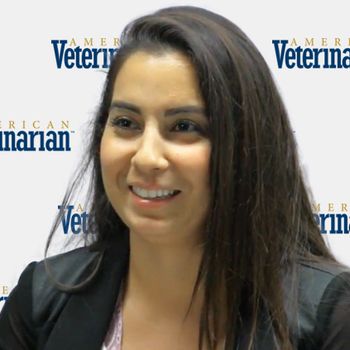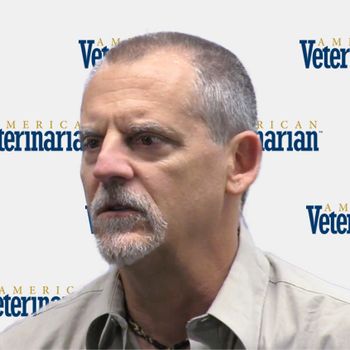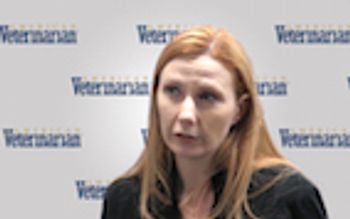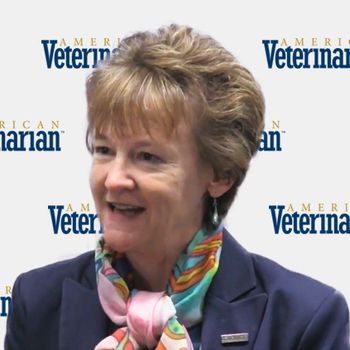
Elizabeth Thomovsky, DVM, MS, DACVECC, associate professor of small animal emergency and critical care at Purdue University, explains how congestive heart failure is the most common reason for respiratory distress in cats.

Elizabeth Thomovsky, DVM, MS, DACVECC, associate professor of small animal emergency and critical care at Purdue University, explains how congestive heart failure is the most common reason for respiratory distress in cats.

Hilal Dogan, BSc., founder of the Veterinary Confessionals Project, talks about the most hilarious confessional she has ever received.

Doug Mader, MS, DVM, DABVP (C/F, R/A), DECZM (Herpetology), owner of Marathon Veterinary Hospital in Florida, explains how taking away beach space and nesting areas has been a major issue with the sea turtle species.

Heather Wilson-Robles, DVM, DACVIM (Oncology), associate professor in the veterinary medicine and biomedical sciences department at Texas A&M University, explains that almost always canines get a different type of lymphoma than cats.

Leslie Mamalis, MBA, MSIT, CVA, owner of Summit Veterinary Advisors, says it’s important for practice owners to understand their financial statements even if it’s the last thing they want to prioritize.

Emily McCobb, DVM, MS, DACVAA, director of shelter medicine in the clinical sciences department at the Cummings School of Veterinary Medicine at Tufts University, describes the different types of pain shelter animals may experience and what veterinarians usually have to treat.

Doug Mader, MS, DVM, DABVP (C/F, R/A), DECZM (Herpetology), owner of Marathon Veterinary Hospital in Florida, explains that this year has been a great nesting season, and believes its due to educating the public and increased monitoring.

Richard Marconi, PhD, professor of microbiology and immunology at Virginia Commonwealth University Medical Center, notes that there are still many problems that researchers need to overcome in the Lyme disease field.

Hilal Dogan, BSc., founder of the Veterinary Confessionals Project, talks about the most touching confessional she has ever received.

Elizabeth Colleran, DVM, MS, DABVP (Feline), practice owner of the Cat Hospital of Portland, chair of the Cat Friendly Program, explains what causes weight loss in cats.

Doug Mader, MS, DVM, DABVP (C/F, R/A), DECZM (Herpetology), owner of Marathon Veterinary Hospital in Florida, wonders how many households actually take their pet reptiles to the veterinarian. He believes the number could be as low as 10% to 20%.

Heather Wilson-Robles, DVM, DACVIM (Oncology), associate professor in the veterinary medicine and biomedical sciences department at Texas A&M University, discusses how and why feline lymphoma has changed over the years.

Leslie Mamalis, MBA, MSIT, CVA, owner of Summit Veterinary Advisors, explains that one of the biggest problems she sees is when an accountant doesn’t use a veterinary-specific chart of accounts when working with a veterinary practice.

Kibble distraction leads to relaxation.

Emily McCobb, DVM, MS, DACVAA, director of shelter medicine in the clinical sciences department at the Cummings School of Veterinary Medicine at Tufts University, explains that pain management doesn’t differ between shelter animals and owned animals in terms of what is required in the standard of analgesia.

Doug Mader, MS, DVM, DABVP (C/F, R/A), DECZM (Herpetology), owner of Marathon Veterinary Hospital in Florida, explains that today, pet owners turn to Dr. Google to find out what is wrong with their pet reptile.

Dr. Philip Bushby has thoughts on this now more complex question and how to work with clients to come to the best decision.

Elizabeth Thomovsky, DVM, MS, DACVECC, associate professor of small animal emergency and critical care at Purdue University, describes some of the top differentials for cats in acute respiratory distress. She divides this into two categories—upper and lower respiratory disease.

Hilal Dogan, BSc., founder of the Veterinary Confessionals Project, says the project accomplishes 3 main things—not feeling alone, letting go of something you’ve been holding back, and building a community.

Doug Mader, MS, DVM, DABVP (C/F, R/A), DECZM (Herpetology), owner of Marathon Veterinary Hospital in Florida, says inappetence is universal across all reptiles and even some amphibians.

Richard Marconi, PhD, professor of microbiology and immunology at Virginia Commonwealth University Medical Center, explains how his canine Lyme disease vaccine, VANGUARD crLyme, is different from other vaccines on the market.

Elizabeth Colleran, DVM, MS, DABVP (Feline), practice owner of the Cat Hospital of Portland, chair of the Cat Friendly Program, discusses why cats 12 years of age and older need more calories in their diets.

Leslie Mamalis, MBA, MSIT, CVA, owner of Summit Veterinary Advisors, describes why budgets are the best way to achieve the goals you have for your veterinary practice.

Richard Marconi, PhD, professor of microbiology and immunology at Virginia Commonwealth University Medical Center, disagrees with the idea that dogs don’t show clinical symptoms of Lyme disease because he says the symptoms are just not outwardly obvious.

Doug Mader, MS, DVM, DABVP (C/F, R/A), DECZM (Herpetology), owner of Marathon Veterinary Hospital in Florida, explains the main reason why so many reptiles still suffer from inappetence.

Valerie Fadok, DVM, PhD, DACVD, dermatologist in the Veterinary Specialty Team at Zoetis, says that most veterinarians have everything they need to diagnose just about any type of skin disease.

Hilal Dogan, BVSc., founder of Veterinary Confessionals Project, expresses why she believes everyone in the veterinary profession needs the Veterinary Confessionals Project on some level.

Rebecca Rose, CVT, president and founder of Catalyst Veterinary Practice Consultants, gives 3 tips on how to get through a difficult conversation you may not want to have.

Leslie A. Mamalis, MBA, MSIT, CVA, owner of Summit Veterinary Advisors, says it is important for associate veterinarians to understand the value that they bring to the practice, the role they play in improving the quality of lives of pets, as well as the role they play as leaders.

CVC educator Candice Hoerner, CVT, VTS (dentistry) makes the case for patient safety.